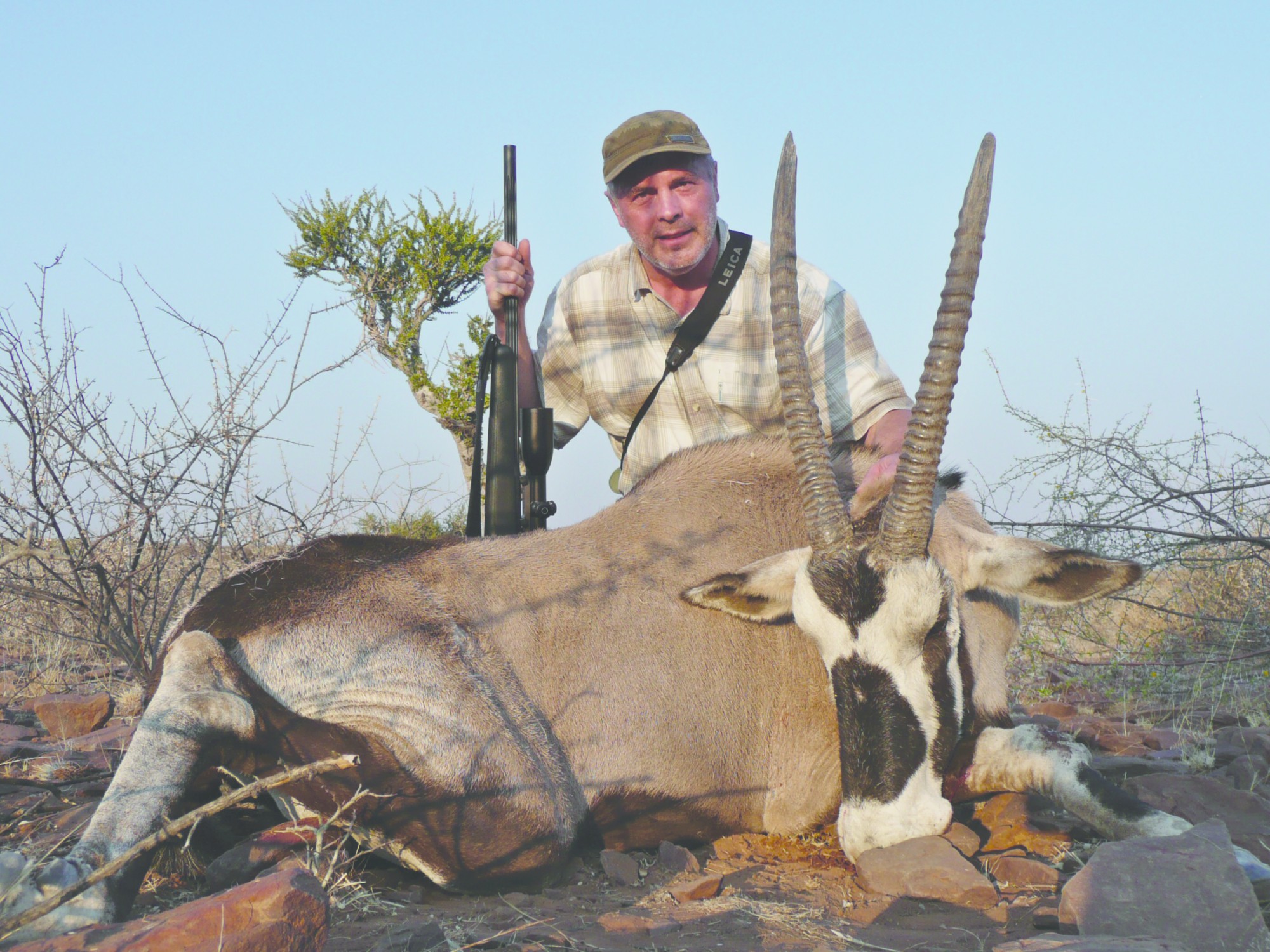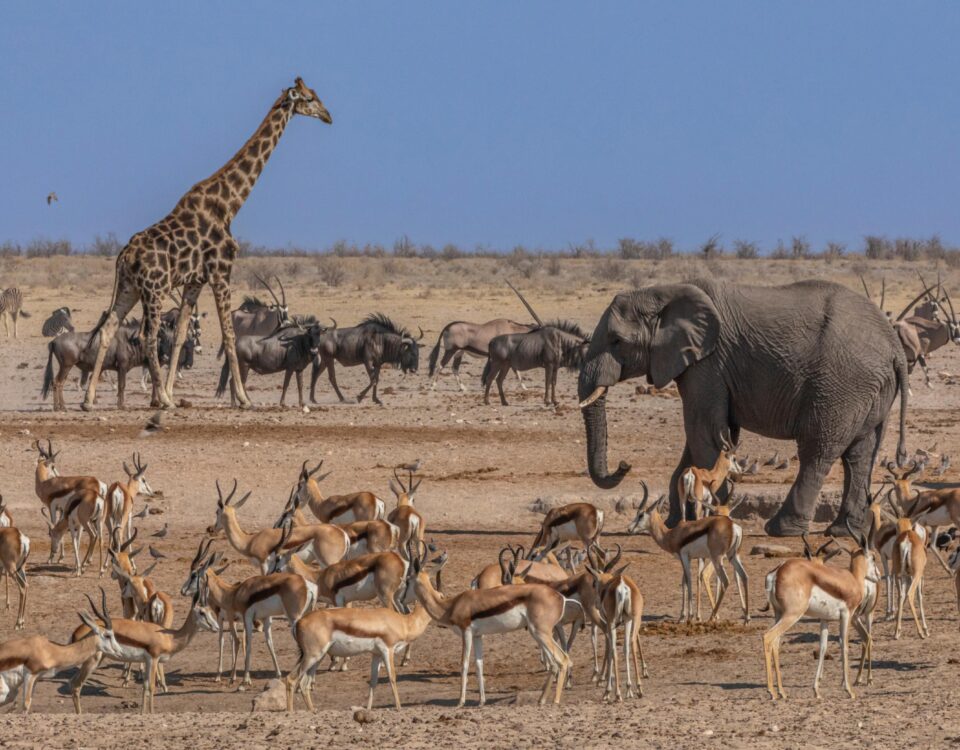
Caprivi dreaming
August 17, 2017
That sunset bull
August 21, 2017W e spotted the very old gemsbok bull on the opposite slope a little less than an hour ago. Now it is already late in the morning and the valiant bull is comfortably standing under a large worm-cure albizia tree which gives him highly valued shade. Keeping our heads down, Roland and I have sneaked forward to a distance of some 600 metres, but now it seems impossible to remain unnoticed and close the gap to shooting distance. The old bull has chosen a perfect shade spot from which he can survey the entire area. Every now and then he turns his head and scents, first in our direction, then to the other side to make sure that no foe is in the vicinity. rough the binoculars he looks absolutely majestic in the shimmering heat, his body massive, the big horns worn. With his battle scars and his beautiful war paint an old fighter like this is truly the king of the desert.
But marvelling will not lead us to success – we have to move on because time doesn’t stand still and by now the sun is roasting us. Cautiously we continue ever so slowly, from one shrub to the next, to take advantage of the little bit of cover there is. Every step has to be taken with the utmost precision in order to avoid the crunching sound of the stones. Occasionally there is some clatter behind me because Roland, of course, is not used to walking on a stony surface like this. Suddenly the bull scents in our direction. “Damn“, Roland whispers behind me, “has he noticed us?” I stop, move my hand backwards in slow motion and indicate to Roland that he mustn’t move. ere we are, not daring to move and the sun beating down on our necks. It seems like a moment frozen in time, despite the scorching heat. The gemsbok bull is still scenting in our direction and now I feel pain coming on in my legs. I am sure it’s the same for Roland, but we don’t have a choice, we have to stick it out. After what seems like an eternity our suffering finally comes to an end: the bull stops scenting. If we don’t change our strategy now it will all have been for nothing. I indicate to Roland that we have to get down again. Down onto the hot stones, to be precise. “Sit on your bum and put your weapon on your lap”, I whisper, “use your hands for support and pull yourself forward with your legs.” And so we edge forward metre by metre. In between we brie y rub our hands on our clothes to prevent blisters, and on we go. Every now and then I turn my head to make sure that Roland is still ok, because the effects of the heat and the physical exertion are written all over his face. But whether we like it or not, we have to continue.
Suddenly I notice that the bull is getting restless. A distance of 400 metres is still far too much for a good shot. Has he noticed us? Has he picked up the scent? No, the wind is in our favour; probably he is simply moving on to find a better tree or water. As I watch him through my binoculars he is slowly moving further up the slope. If he disappeared behind the hill soon it would be the perfect opportunity for us to quickly catch up and perhaps get a shot on the other side. But for now we just have to wait.
Close behind me Roland is sitting on the searing hot stones, carefully removing thorns from his hand. Suddenly the third line of the Südwesterlied comes to mind, the song which in a way served as an unofficial ‘national anthem’ before independence. The lyrics are about everlasting love for this arid land, despite its hardships – such as crags burnt by the sun. The sun is really making a good job of it, also today.
But while the crags and stones seem to have no problem with getting scorched, a human being exposed to these conditions will become very much aware of being in Africa. The gemsbok takes his time, nibbles on a blade of grass here and there, scents briefly, strains his ears in all directions and majestically continues up the hill without hurry. It is clear that he is at home in this rough terrain. Despite his massive body he negotiates it with incredible ease. He seems like an old man on a sidewalk who imagines himself to be a lot younger. We are still sitting on these burning hot stones, but not for much longer, and then we will have to act fast. Now he is up there, against the horizon, and in the shimmering heat he blends into the landscape so perfectly that he almost fades from sight. His mighty horns are the last of him that I see as he disappears over the horizon.
Now we have to hurry if we want to take him on the other side. We try to catch up as quickly as possible, which is easier said than done in this heat and with all the stones on the ground. One has to be very careful not to stumble – a fall could be rather painful. After the first 200 metres I have to check my pace so that Roland isn’t lagging too far behind. He really seems to be struggling with the stones. But we have to keep moving. We are already climbing up the slope where the bull was resting not so long ago. As I point out the tree where he stood in the shade Roland has a brief chance to catch his breath, then we continue up the hill. Approaching the top we are slowing down again to avoid the clattering of stones. Hopefully he hasn’t heard us yet and cleared off…
But since we don’t know what the situation is we have to continue cautiously and hope that we don’t mess things up if he still happens to be there. Searching for a sign of his presence I am looking ahead with utmost concentration. He can be anywhere on the slope below us.
I motion to Roland that we have to be very cautious now and that he needs to take a deep breath because he is still gasping for air and with his heart beating like mad it will be difficult for him to place a good shot.
As I take another step forward I discover something dark at an angle below us. Slowly I reach out for the binoculars and recognise him clearly: it is the bull we have been looking for, the bull with the short but heavy horns. ere he is! Please don’t make a mistake now. He hasn’t noticed us yet and is busy rubbing his horns on a dry silver cluster-leaf shrub. “Too many shrubs”, I whisper in Roland’s direction, “we need to go further to the right.” Slowly I get down to the ground and indicate that it is back to bum on the stones, weapon on the lap and go!
“A real old fighter, a king of the desert.In moments like this the hunter experiences a sense of gratitude and satisfaction which is hard to describe.”

The bull is still busy with his horn care. We have to exploit that because he is a little distracted and not so alert at the moment. A few metres further on I discover a gap. Our bull is less than 100 metres below us on the slope, but unfortunately his body is pointing downward which is not good for a shot. ‘Perhaps he’ll turn his broadside to us just now’, I think and am about to put up the shooting sticks slowly and carefully. At that very moment the bull notices some movement and across his shoulder attentively scents into our direction. With the sticks still in my hand I freeze and barely dare to breathe. I pray that Roland won’t move either; otherwise it would be all in vain.
Luckily the bull seems satisfied that he is not in danger and after a brief moment continues to rub his horns on the shrub. I carefully put up the sticks and indicate to Roland that he must take his position, because the bull might turn around and scent in our direction again. Roland has taken his position and tries to keep his heartbeat under control. Now we just have to be patient again and wait.
In the meantime the sun has reached its zenith and in a situation like this you wonder whether the hot stones are worse than the parched throat or whether the hunting fever surpasses everything. After waiting for a while I decide to whistle, in the hope that the bull will turn his side to us and Roland can get his shot. My brief whistling causes the bull to raise his head but he scents to the other side. I whistle again and there he turns his side to us and with a fright scents in our direction. “Now! Shoot!” I have barely uttered the words when the shot cracks. Through the binoculars I see the massive body of the old bull collapse. “Repeat and keep aim”, I instruct Roland. But after a few minutes there seems to be no movement left. He is lying there, stone-dead.
We go down to him and Roland, too, realizes that his bull is indeed as old as the hills. A real old fighter, a king of the desert. The effort has been well worth it and in moments like this the hunter experiences a sense of gratitude and satisfaction which is hard to describe. Joy is written all over Roland’s face. “Now I know what hunting in Africa means”, he says, “with aching legs across these hot stones!”
This article was first published in the HuntiNamibia 2017 issue.
Many oryx, one gemsbok
The gemsbok is Namibia’s national animal, appearing in the state’s coat of arms – as well as in the logo of Namibia Parks and Wildlife, the park management division within the Ministry of Environment and Tourism. Taxonomically, the gemsbok falls within the genus Oryx. A number of distinct species and subspecies of this genus are distributed across parts of Africa and the Arabian Peninsula. These include the Arabian oryx (Oryx leucoryx), the scimitar-horned oryx (Oryx dammah) and the beisa oryx (Oryx beisa). A subspecies of the beisa oryx, the fringe-eared oryx (O. beisa callotis) has distinct tassels fringing its ears, and is more ochre in colour. In tourism circles, partly encouraged by travellers familiar with East Africa’s beisa oryx, the name oryx has been used increasingly for the gemsbok. is is not entirely correct. ere are many oryx, but there is only one gemsbok – the southern African Oryx gazella, indigenous to the drier parts of the subcontinent.



